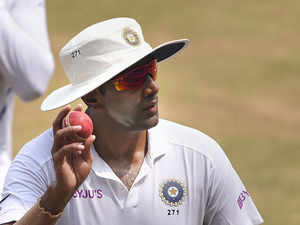 PTI
PTIRohit Sharma rode the Visakhapatnam Test wave, centuries in each innings, when he opened the batting for the first time. Mayank Agarwal made his first Test century, a carefully crafted double, and walked away with deserved plaudits.
Ravindra Jadeja bagged his 200th Test scalp and became the fastest left-armer to do so. And Mohammad Shami rounded off India’s win with a striking five-wicket haul in the second innings, a rarity for Indian quicks.
But, the first Test against South Africa was more critical to one man than any of these, and he played a pivotal role in allowing India to press home the advantage. Playing his first international game in 2019, R Ashwin was a captain’s dream in the first innings when the wicket was doing precious little.
South Africa had picked three spin options, Keshav Maharaj, Dane Piedt and Senuran Muthusamy, and yet India merrily amassed 502 before declaring. But the difference in class became obvious when Ashwin had the ball in hand. For starters, he did not roll his fingers over the ball, like fellow offie Piedt, but rather imparted revolutions on it with the express aim of getting the ball to dip.
He did not float it out there, as Maharaj had, but used his thumb to direct the ball, getting the most natural variation, the ball sometimes landing on seam, gripping and turning and at other times leather making first contact with pitch and the ball skidding on. He did not approach the crease looking to do damage control, as Muthusamy had, but built blocks of deliveries that set the batsman up for the sucker ball.

Ashwin took seven wickets, only seven of 10, and when you consider that 85 overs were bowled by others for three wickets, it tells you just how good he was. With 8 for 199 in the match (7 for 145 in the first innings) Ashwin became the joint fastest bowler to 350 scalps. The quickest in the history of the game, matching Muttiah Muralitharan. The thing though, is that Murali was the first name on Sri Lanka’s team sheet every time they played a Test. It mattered little who the captain was, what the conditions were, or who the opposition was. Ashwin’s story is a little different.
Virat Kohli, in his first Test as captain, standing in for Mahendra Singh Dhoni in Adelaide in 2015, left Ashwin out, choosing the leg breaks of Karn Sharma instead. Even as Nathan Lyon took 12 wickets as Australia won, India’s spinner took four wickets for 238 runs at an economy rate of 4.8. That set the ball rolling for Kohli, and Ravi Shastri, as coach, to leave Ashwin out on multiple occasions.
In England, in South Africa, in West Indies, the world’s most effective spinner statistically was left out of the Indian team when he was fit. Most recently, in Australia, the circumstances were most curious.
A day before the Sydney Test, Kohli ruled out Ashwin at a press conference and talked about how Hanuma Vihari “looked like picking up a wicket whenever he comes to bowl”. Soon after the official release from the team management had a 13 that included Ashwin. He eventually did not play, no explanation offered, with Kuldeep Yadav making the cut.
Most recently, in the West Indies, India picked Ashwin for two Tests without playing him. When he made an immediate impact, against South Africa, Sunil Gavaskar was quick to call out the team management for the manner in which Ashwin had been treated. “Ashwin should be a certainty. The fact that he has not been made to feel the comfort level is the reason why we are seeing him struggle a little bit,” Gavasakar said. “He has also got to feel he has got the confidence of the people around him. When you don't have the confidence of people around you, when you keep getting sidelined, then you try a little too hard.”
Gavaskar went one step further, suggesting that it was not cricketing logic alone that the management went by when leaving Ashwin out. “I think there is more to it than just cricketing performances which is the reason he just finds himself sidelined more often than somebody with his record should be. Somebody who has got almost 350 wickets can't be sidelined as regularly as he has been.”
Horses for courses is a statement constantly trotted out in cricket, but a thoroughbred such as Ashwin should be allowed to run free on all courses, all things being equal in Indian cricket.
(Catch all the Business News, Breaking News, Budget 2024 Events and Latest News Updates on The Economic Times.)
Subscribe to The Economic Times Prime and read the ET ePaper online.
Read More News on
(Catch all the Business News, Breaking News, Budget 2024 Events and Latest News Updates on The Economic Times.)
Subscribe to The Economic Times Prime and read the ET ePaper online.









 Get Unlimited Access to The Economic Times
Get Unlimited Access to The Economic Times
